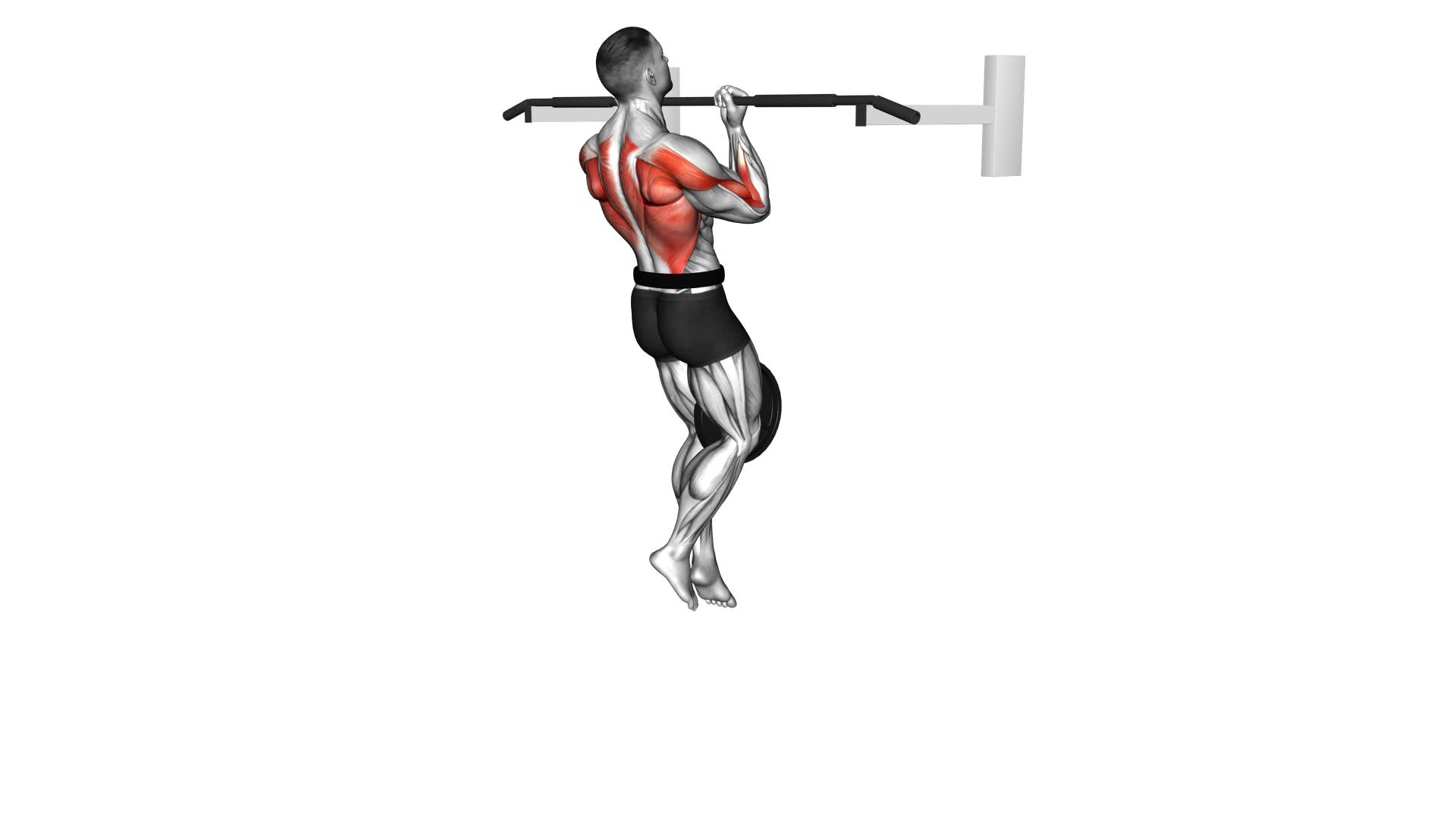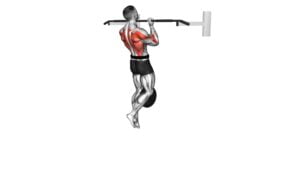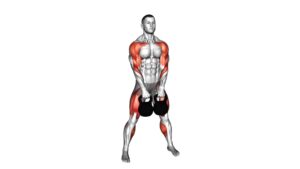Weighted Hang Chin-up – Video Exercise Guide & Tips

Looking to take your chin-up game to the next level?
Watch This Exercise Video
In this video exercise guide, we'll show you how to master the weighted hang chin-up.
With this challenging variation, you'll not only build upper body strength but also improve your grip and core stability.
Get ready to push your limits and achieve new heights in your fitness journey.
So grab your equipment and let's dive into this intense workout.
Key Takeaways
- Weighted hang chin-ups can increase strength and muscle development.
- They target multiple muscle groups simultaneously.
- Weighted hang chin-ups build upper body strength and work the forearms and grip strength.
- Proper form and technique, such as engaging the core and maintaining a full range of motion, are important for effective execution.
Benefits of Weighted Hang Chin-ups
You will experience increased strength and muscle development by incorporating weighted hang chin-ups into your workout routine. The benefits of this exercise are numerous, as it targets multiple muscle groups simultaneously. One of the primary advantages is the ability to build upper body strength. As you pull yourself up, your latissimus dorsi, biceps, and trapezius muscles are heavily engaged, resulting in increased muscle mass and definition. Additionally, weighted hang chin-ups also work your forearms and grip strength, as you need to hold onto the bar while performing the exercise.
Another benefit of weighted hang chin-ups is the improvement in your pulling strength. This exercise helps to strengthen the muscles involved in pulling motions, such as the back and arms. These muscles play a crucial role in various activities, such as lifting heavy objects or performing sports movements that require upper body strength.
Incorporating weighted hang chin-ups into your workout routine can also enhance your overall posture. The exercise targets the muscles of the upper back, which are responsible for maintaining proper posture. By strengthening these muscles, you can improve your posture and reduce the risk of developing back pain or injuries.
In conclusion, incorporating weighted hang chin-ups into your workout routine offers a range of benefits, including increased strength, muscle development, improved pulling strength, and enhanced posture. These benefits make it an excellent addition to any fitness program.
Now, let's move on to the next section, where we'll discuss proper form and technique for performing weighted hang chin-ups.
Proper Form and Technique
To perform weighted hang chin-ups with proper form and technique, it's important to focus on maintaining a strong grip and engaging the necessary muscle groups throughout the exercise. Here are four key points to keep in mind:
- Grip: Start by gripping the bar with your palms facing towards you, slightly wider than shoulder-width apart. Ensure your fingers are securely wrapped around the bar for a solid grip.
- Shoulder Position: Pull your shoulders down and back, away from your ears, to activate your upper back muscles and maintain proper posture throughout the movement.
- Engage the Core: Tighten your abdominal muscles and squeeze your glutes as you lift your body up towards the bar. This ensures stability and helps protect your lower back.
- Full Range of Motion: Lower your body until your arms are fully extended, and then pull yourself up until your chin is above the bar. Aim for a slow and controlled movement, avoiding any swinging or kipping.
Common mistakes to watch out for include using momentum to complete the movement, allowing the shoulders to shrug up towards the ears, and neglecting to engage the core.
Equipment Needed for Weighted Hang Chin-ups
Maintaining proper form and technique during weighted hang chin-ups requires the use of specific equipment. To add extra weight to your chin-ups, you'll need weighted chin-up accessories. These accessories typically include a weight belt, weighted vest, or dip belt, which allow you to attach weight plates or dumbbells securely. Ensure that the equipment you choose can handle the desired weight safely.
When selecting weighted chin-up accessories, consider safety considerations for weighted chin-ups. It's essential to choose equipment that's sturdy and can handle the additional weight without compromising your safety. Make sure that the weight is evenly distributed and doesn't shift during the exercise, as this can throw off your balance and increase the risk of injury.
Additionally, it's important to have a spotter or use a power rack with safety pins when performing weighted hang chin-ups. A spotter can provide assistance if needed and ensure your safety throughout the exercise. The power rack with safety pins can catch the weight if you're unable to complete the repetition, preventing any accidents or injuries.
Now that you're aware of the equipment needed and the safety considerations for weighted hang chin-ups, let's move on to the next section: variations and progressions.
Variations and Progressions
To continue building strength and challenging yourself in your weighted hang chin-up routine, consider exploring different variations and progressions. Here are four variations and advanced techniques you can incorporate into your workout:
- Wide Grip Chin-ups: Place your hands wider than shoulder-width apart on the bar. This variation targets your lats and improves overall upper body strength.
- Narrow Grip Chin-ups: Bring your hands close together on the bar, with your palms facing you. This variation places more emphasis on your biceps and forearms, helping to develop a stronger grip.
- Archer Chin-ups: Start with a wide grip chin-up, then shift your weight to one side as you lower yourself down. This variation challenges your stabilizer muscles and increases the demand on your back and arms.
- One-arm Chin-ups: Once you have mastered regular weighted chin-ups, you can progress to this advanced technique. Start by gripping the bar with one hand while keeping the other hand on your wrist for support. Gradually reduce the assistance from your supporting hand until you can perform a full one-arm chin-up.
By incorporating these different grips and advanced techniques into your routine, you can continue to challenge your muscles and make progress in your weighted hang chin-up workout.
Now let's move on to the next section to learn some tips for maximizing your workout.
Tips for Maximizing Your Weighted Hang Chin-up Workout
To optimize your weighted hang chin-up workout and achieve maximum results, focus on implementing effective strategies and techniques. By avoiding common mistakes and targeting specific muscle groups, you can enhance the effectiveness of your workout.
One common mistake to avoid is using too much weight too soon. It's important to gradually increase the weight you use to avoid injury and allow your muscles to adapt. Start with a weight that challenges you but still allows you to maintain proper form and technique.
Another mistake to avoid is neglecting proper form. Make sure to engage your core, keep your shoulders down and back, and use a controlled motion throughout the exercise. This will ensure that you're targeting the intended muscle groups and minimizing the risk of injury.
When performing weighted hang chin-ups, you primarily target the muscles of your back, specifically the latissimus dorsi, rhomboids, and trapezius. Additionally, your biceps and forearms are also engaged during the exercise.
To maximize the effectiveness of your workout, consider incorporating variations and progressions into your routine. This can include using different grip positions, increasing the weight gradually, or adding in other exercises that target the same muscle groups.
Frequently Asked Questions
What Are the Potential Risks or Injuries Associated With Weighted Hang Chin-Ups?
When doing weighted hang chin-ups, there are potential risks and injuries to be aware of. Adding weight to this exercise increases the strain on your muscles and joints, increasing the risk of strains, sprains, or even tears.
It's important to start with a weight that you can comfortably handle and gradually increase it over time. Proper form and technique are crucial to avoid putting excessive stress on your shoulders, elbows, and wrists.
Always listen to your body and stop if you feel any pain or discomfort.
How Often Should Weighted Hang Chin-Ups Be Incorporated Into a Workout Routine?
To optimize your workout routine, it's crucial to determine how often you should incorporate weighted hang chin-ups. This exercise targets your upper body, specifically your back, shoulders, and arms. By adding weight, you increase the intensity and challenge your muscles even more.
However, the frequency of this exercise will depend on your overall fitness level, goals, and recovery ability. It's recommended to consult with a fitness professional to create a personalized plan that suits your needs.
Can Weighted Hang Chin-Ups Help Improve Grip Strength?
Weighted hang chin-ups can be a great exercise for improving grip strength. By adding weight to the exercise, you're challenging your muscles to work harder, which can lead to increased grip strength over time.
The benefits of weighted hang chin-ups extend beyond just grip strength, as they also target your back, biceps, and core muscles. Incorporating this exercise into your routine can help you develop a stronger grip and overall upper body strength.
Are There Any Modifications for Individuals With Limited Upper Body Strength?
If your upper body strength is limited, there are modifications and alternative exercises you can try.
To improve grip strength without doing weighted hang chin-ups, you can focus on exercises like farmer's carries, dead hangs, or using grip strength trainers. These exercises target the same muscles and can help build strength gradually.
Additionally, you can start with assisted chin-ups or negative chin-ups, where you focus on the lowering phase, to build up your upper body strength before attempting weighted hang chin-ups.
Is It Necessary to Use Additional Weight for Weighted Hang Chin-Ups, or Can Body Weight Alone Be Sufficient for a Challenging Workout?
To challenge yourself during a weighted hang chin-up, you can add additional weight. However, it isn't necessary as your body weight alone can provide a challenging workout.
The benefits of using additional weight include increased strength and muscle growth. If you're looking for variations, you can try different grips, such as wide or narrow, or incorporate a pause at the top or bottom of the movement.
Remember to always maintain proper form and listen to your body.
Conclusion
In conclusion, the weighted hang chin-up is a highly effective exercise for building upper body strength and improving grip strength. By adding weight to your body while performing this exercise, you can challenge your muscles even further and see greater gains.
Remember to maintain proper form and technique to avoid injury and make the most out of your workout. With the right equipment and variations, you can continue to progress and push your limits.
Follow these tips and enjoy the benefits of a strong and powerful upper body.

Author
Years ago, the spark of my life’s passion ignited in my mind the moment I stepped into the local gym for the first time. The inaugural bead of perspiration, the initial endeavor, the very first surge of endorphins, and a sense of pride that washed over me post-workout marked the beginning of my deep-seated interest in strength sports, fitness, and sports nutrition. This very curiosity blossomed rapidly into a profound fascination, propelling me to earn a Master’s degree in Physical Education from the Academy of Physical Education in Krakow, followed by a Sports Manager diploma from the Jagiellonian University. My journey of growth led me to gain more specialized qualifications, such as being a certified personal trainer with a focus on sports dietetics, a lifeguard, and an instructor for wellness and corrective gymnastics. Theoretical knowledge paired seamlessly with practical experience, reinforcing my belief that the transformation of individuals under my guidance was also a reflection of my personal growth. This belief holds true even today. Each day, I strive to push the boundaries and explore new realms. These realms gently elevate me to greater heights. The unique combination of passion for my field and the continuous quest for growth fuels my drive to break new ground.







